The Vintage Enthusiast: The most advanced high-end 35mm AF SLR film camera from Nikon.
The Nikon F80 (N80 in the US), one of the most advanced of Nikon's SLR cameras, was launched as a high-end enthusiast model in January 2000, to succeed the F-801s (N8008s), which it replaces. The camera, which comes with a built-in flash, was built based on the technology of the highly successful Nikon F100 but comes without weather sealing and the shade of ruggedness that was associated with the former.
The F-80 is fitted with an electronically controlled vertical-travel focal-plane shutter with a speed range from 30 seconds to 1/4000 second, and B(ulb), with a flash sync speed of 1/125 second. The metering range is from EV 0 to EV 21 (ISO 100, F1.4) for Evaluative 3D Matrix and 75% Center-Weighted Average, and EV 3 to EV 21 (at ISO 100) for Spot Metering. The camera accepts DX-coded films with an ISO speed range from 25 to 5000, while non-DX films can be manually set from ISO 6 to 6400.
Exposure modes available are Auto-Multi Progam, Shutter-Priority Auto, Aperture-Priority Auto, and Manual. Metering is TTL (Through the Lens) open aperture with a 10-segment Matrix sensor for Matrix Metering, 12mm-diameter center circle for Center-Weighted, and selected focus area for Spot Metering. 3D Matrix Metering by adding distance information to determine the correct exposure is used when the camera is fitted with D- or G-type Nikkor lenses.
Three versions of the F80 are available, the standard F80, the F80D, which has a different back with date imprint functions, and the F80S which adds imprinting of exposure data information between the film frames to the date imprint capability.
Nikon F80 / Nikon n80 - Walkthrough and Review
Nikon's N80 (F80), essentially an F100 with a few features removed, is a viable alternative to the higher-end Nikons of the day like the F100 and F5. The N80 had an astounding nine-year production run at a time when most camera models of its class only lasted two or three. That production run is a testament to how well made, how well liked, and how popular these cameras were. If you want a camera that can do essentially everything you need but with less weight than the F100 and F5, the N80 is a solid choice.
The F80 is compatible with Nikon F mount lenses, the preferred lenses include AF, AF-D, and AF-S lenses, all functions of the camera and program modes P, S, A, and M will operate with these lenses. VR-enabled lenses will work as well. AI, AI-S, as well as converted AI lenses can mount will work but without a light meter function or aperture info.
The two cameras, the F100 and F80, together with the midrange F75 (N75) were the last of Nikon's 35mm SLR film cameras before Nikon went digital. The F80 was also the basis for the development of the D100 digital SLR, FinePix S2 Pro and S3 Pro by Fujifilm, and Kodak DCS Pro 14n and DCS Pro SLR/n by Eastman Kodak.
Basic Camera Features
Though it is of an all-plastic body with a metal lens mount, with a form factor that is closer to a compact camera than that of a bulky SLR, the F80 feels packed and solid in the hand, and with its fuss-free design and a simple working interface, it should be a delight to be the owner of one.
With a weight of only 520 grams for the F80D, the camera is a definite yes in the gear-carrying department. Just as well, with its well-damped and surprisingly quiet mirror slap/shutter actuation, the F80 could just be there to steal the show.
On the front, just below the power/shutter release button situated on top of the handgrip, is the exposure sub-command dial. Next, in the recess between the handgrip and lens housing mount is the DoF (Depth of Field) preview button located below the Self-Timer/AF Assist Illuminator/Red-Eye Reduction lamp.
The lens housing mount is a fair proportion of the smallish body, and to the right of it, on the lower part of the body, the Focus Mode Selector, and above it, the lens release button.
On the top plane, at the extreme left, are the film advance mode setting with a lock button release, and the PASM program mode, integrated with the Exposure Mode/Custom Setting/Film ISO Speed selector dial. On top of the pentaprism is the button release built-in flash unit, and the additional hot-shoe for external flash units.
To the right, the LCD unit, and on the hump of the finger grip, the Shutter Release Button, Power On/Off switch, Exposure Compensation button, and Flash Exposure Compensation button. An LCD Illuminator Switch, which also doubles up as one of the Film Rewind buttons is right on the shoulder of the top plate.
On the back of the top plane, from left to right, is the Auto Exposure Bracketing button, and the Flash Sync Mode button, which is also the other half of the twin Film Rewind button system. On the back of the pentaprism hump is a decent size viewfinder window. To its right is the AE-L/AF-L lock button, integrated with the Metering System Selector dial.
Just where your thumb rest is the Main Command Dial, used in conjunction with all mode selection options available on the F80.
On the film back itself, the Focus Area Selector dial on a compass point jog wheel, and for the 80D version, the Date Imprint LCD panel, and just below it, the AF Area Mode Selector.
A very simple bottom with a ribbed surface, a tripod socket, and a battery chamber cover.
The film box is a standard Nikon AF camera layout with the DX-pinned film canister chamber located on the left, followed by the shutter window, sprocket gear, and take-up spool to the right of the camera body.
Film Loading and Rewind
A single latch lock mechanism opens up the quick-load film box. Film loading is easy and fuss-free. With the camera power On, open the film back, insert the film canister into its bay, pull the film tab firm across the film frame mechanism up to the right index mark, and close the back. The camera's auto modes will take over from there.
Film rewind at the end of the roll can be set to be automatic, or manual, by pressing the 2-rewind icon buttons on the camera body simultaneously.
Viewfinder Readout
The F80 is the first Nikon camera to feature on-demand grid lines. You can set this on by accessing option (#4) on the custom menu setting.
Aside from the on-demand grid display, the screen is also etched with a 12mm diameter reference circle for the Center-Weighted Metering area, and Focus Brackets which also act as Spot Metering areas.
The focus brackets, North, South, East, West, and Central, are controlled by the Focus Area Selector jog-wheel located on the film back.
Along the lower part of the viewfinder display is the LCD panel (with built-in illuminator) that displays the DX indication, Shutter Speed/Exposure Compensation value, Aperture, Exposure Compensation, Flash Exposure Compensation, Auto Exposure Bracketing, Bracketing bar graphs, Custom, Flexible Program, Flash Sync mode, AF Area mode, Focus area, Battery power, Film Frame counter, and towards the right, the Flash Ready icon.
The viewfinder is fitted with diopter correction.
LCD Panel Info
The LCD panel, located on the right of the top plane, is aft of the Shutter Release button, Power On/Off button, Exposure Compensation, and Flash Exposure Compensation buttons oval which is located on top of the handgrip displays all the relevant info on the mode settings for the camera.
These include Shutter Speed/Exposure Compensation value, Flash Exposure compensation, Exposure compensation, Flexible Program, DX indicator, Flash sync mode, Bracketing bar graphs, Aperture, Custom Setting, Battery power, Film frame counter, Focus area, and Auto Exposure Bracketing.
Camera Operations
As with modern cameras that are electronically ahead of their all-manual counterparts of yesteryears, the F80 is equally competent at all the functions and tasks it can do. As a general overview, the following bullet points may show you the areas to address and give emphasis to as you read through the instruction manual:
- Pop-up flash - The F80 is fitted with a pop-up flash, called 'Speedlight' by Nikon, which provides an angle coverage of a 28mm lens with a guide number of 12 (ISO 100, m).
- Film advance modes - Selectable Single and Continuous film advance modes. When using Continuous Servo AF mode with C film advance mode, the F80 delivers a film advance speed of approximately 2.5 fps.
- Two Command Dials - The Main-Command Dial is used to select the shutter speed when using Shutter-Priority Auto or Manual, and a range of other camera settings. The Sub-Command Dial allows you to select aperture with Aperture-Priority Auto or Manual. Custom Setting #12 lets you switch the functions of the two Command Dials.
- Exposure System - The F80 comes with a fully programmed automatic exposure system, with a shutter speed range from 30 seconds to 1/4000 seconds, with B, and 1/125-second flash synchronization.
- Exposure Programme Modes - Standard, as most of us know by now, are the Exposure Programme Modes as provided for on the F80, which are Auto Multi-Program (P), Shutter-Priority (S), Aperture-Priority (A), and Fully Manual (M).
- Metering - The metering system is a choice of Matrix Metering with a 10-segment Matrix Sensor or 3D Matric Metering with Nikon D or G lenses, Center-Weighted Metering with emphasis on the 12mm diameter circle in the viewfinder, and Spot-Metering where the metering sensitivity is concentrated on selected focus areas of the viewfinder.
- Autofocus Mode - Autofocusing selection is provided by 2 options, Single Servo AF with Focus-Priority (S), and Continuous Servo AF with Release Priority (C). The D80D does not provide a Manual Focus (M) option.
- AF Area Modes - AF area mode selection can be set to Single Area AF, which uses only the selected focus area of the viewfinder, or Dynamic AF, which provides accurate focusing with subjects that move irregularly.
- Custom Setting - The F80 provides a myriad of custom settings that will help you to get the better of the camera. All in all, 18 options are available for the F80D (19 on the F80S). This includes setting for Automatic film rewind at the end of the film roll (#1), to AF-Assist Illuminator activation (#18).
Lens Compatibility
The F80 is compatible will all F-mount Nikkor lenses except for pre-AI, and all IX lenses, which may damage the camera when mounted. Older Nikkor non-CPU A and Ai-S lenses can be mounted on the camera, but exposure must be set manually as the camera will not meter through them at all.Data Back
The F80D and F80S allow you to imprint Year/Month/Day, Day/Hour/Minute (24-hour clock), Month/Day/Year, or Day/Month/Year on your picture. This can be done in any exposure mode.Battery
The Nikon F80 requires a pair of CR123A Lithium battery packs to operate.Camera Body Weight
The camera's body weight is approximately 515 grams for the F80, 520 grams for the F80D, and 525 grams for the F80S.Instruction Manual
The English version of the F80, F80S, and F80D shared instruction manual, which you can download from NikonSupport.EU is a hefty 115-page booklet. Take your time to study the pages and elevate yourself to that of a 'guru' of the F80.The Clinker
Against all the criticisms, brickbats, and head butts leveled at the Nikon F80, where most are centered solely on the fact that the camera does not do metering on dated manual focus lenses, I still have no qualms in claiming that the F80D, the unit I was using, with AF Nikkor lenses, is among the top 35mm AF SLR film cameras that I have reviewed and used, bar none.A pair of CR123As to operate the camera? Yes, that could be another clinker but the batteries are not that hard to find. And the effect of using manual AI Nikkor lenses on the F80? Do not use it on the D80, you will have no benefit of any metering at all.

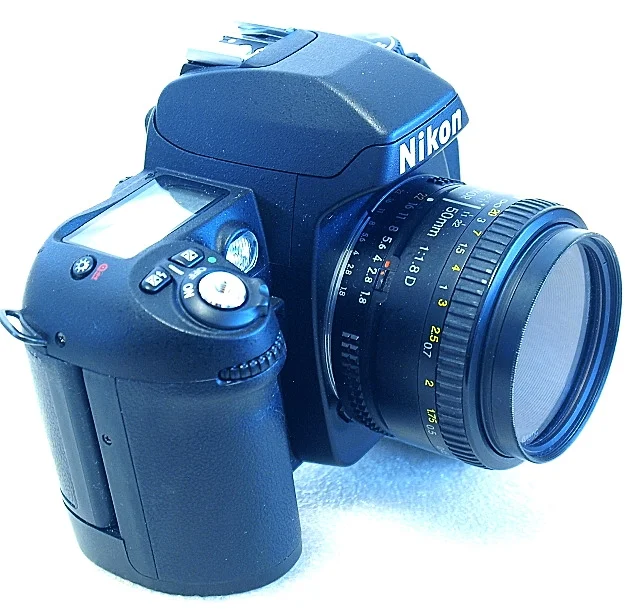
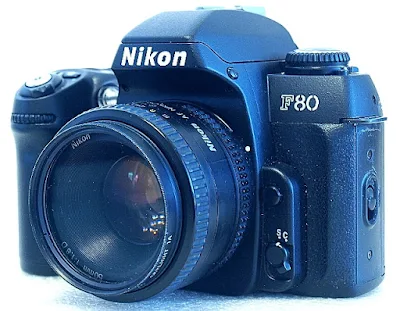
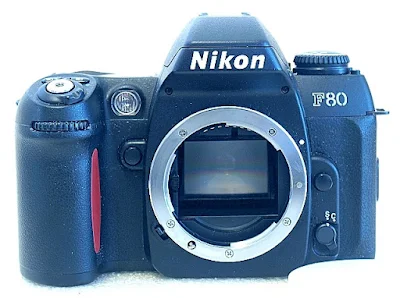
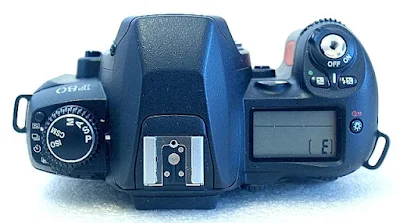
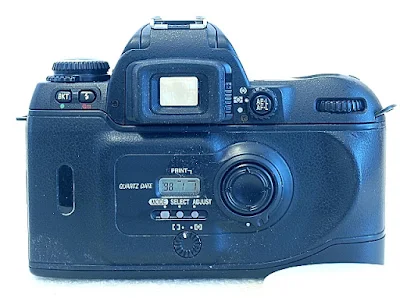
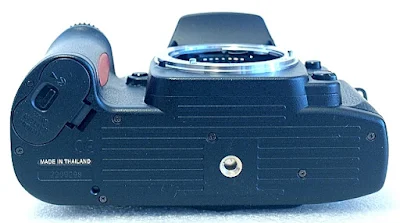















Top shutter speed is 1/4000 .
ReplyDeleteCorrected, thanks.
DeleteMaksymalny czas synchronizacji z lampą 1/125 sekundy.
ReplyDeleteAh, the Nikon F80, the camera that's like the Goldilocks of the photography world – not too big, not too small, just right! It's got that all-plastic body, but don't let that fool you; it's like a ninja in disguise, ready to capture the perfect shot when you least expect it. And let's not forget the DoF preview button – it's like a secret handshake for photographers. "Oh, you shoot with an F80? Me too! Do the DoF dance!" Cheers to the camera that's quietly stealing the show, one perfectly exposed frame at a time!
ReplyDeleteThe F80, what can I say other than nice? This the camera that Nikon got really right. I still have mine and it is the one I reach for when the mood is on me to burn some film. As Lucas says, "It is just right". I have even had the body "de-stickied" so I can keep using it.
ReplyDeleteI just bought a 2nd F80 dirt cheap. I am using the 28-70/3.5-4.5D since my Nikon F90x days, and now i can decide, Color Film or B&W...same body, same lens. My #1 lens choice is the 35mm F2D Nikkor. Great for everything. With the F80, small & handy.
ReplyDelete